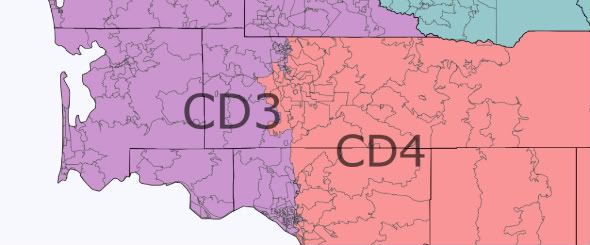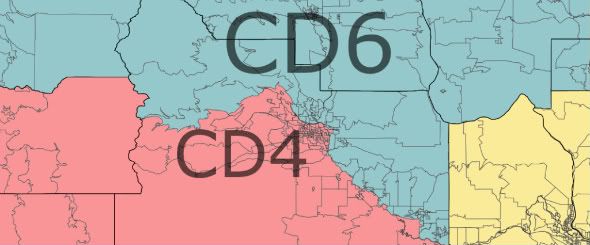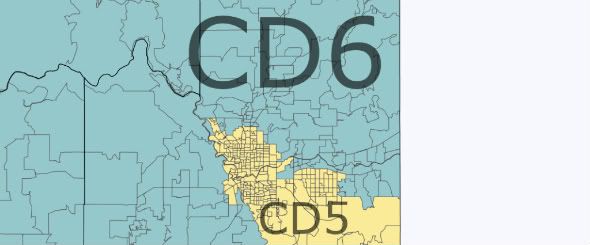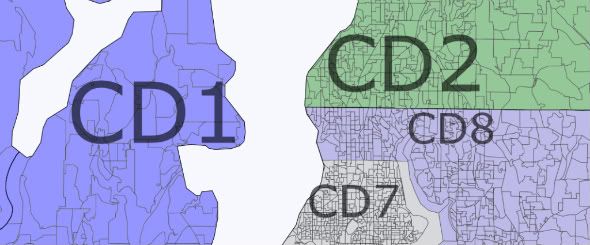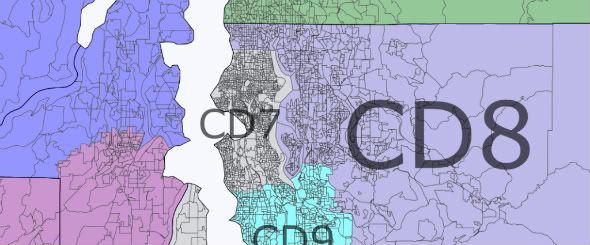My second attempt at redistricting California. I scrapped my first attempt, because it didn’t look quite like something the commission would do in most places, after reading some comments and taking a second look, I saw many flaws. Now this map isn’t perfect and I’m not as good at this as some other members, but I did my best and it looks a lot better than the last one. It’s probably 75% close to what we might see from the commission.
Revision: I modified some of the Central Valley and Bay Area Districts.
Goals:
Avoid county and city splitting where possible.
Attempt to follow communities of interest.
Keep lines looking as clean as possible.
Possible Incumbent face offs:
Garamendi vs. Lungren
Honda vs. Stark
Cardoza vs. Denham
Gallegly vs. Sherman
Napolitano vs. Sanchez
Davis vs. Bilbray (rematch)

Uploaded with ImageShack.us
CA-1: (Blue)
OPEN
Obama 50%, McCain 47%.
This district includes much of the old CA-1 and CA-2. It compacts this part of the state, which was previous very gerrymandered. It’s the definition of a swing district, with a PVI of R+1. I have no idea who would run here on the Democratic side, but there are several Republican legislators who have been termed out who could make of a go of it.
CA-2: (Green)
Mike Thompson
Obama 65%, McCain 33%
Mike Thompson’s district gets a whole lot smaller, as it shrinks down to include just Napa, Solano and a portion of Yolo County.
CA-3: (Purple)
Wally Herger
McCain 51%, Obama 46%
Herger’s hometown of Chico is still here, as well as some previously represented territory, but it’s more squared off to look compact. I couldn’t get the population just right on this one, but I estimate that new population numbers would probably allow for this district to balance out.
CA-4: (Red)
Tom McClintock
McCain 55%, Obama 43%
McClintock loses some counties in the north and picks up some other counties to further south. Inyo, Alpine and Mono are always hard to place because of their position, I can’t be sure where the commission would place them, but this wouldn’t be an unreasonable place. Population was a little off here too, but it would likely balance out with new census numbers.

Uploaded with ImageShack.us
CA-5: (Gold)
Doris Matsui
Obama 69%, McCain 29%
Not much to say here, it’s practically the same as it was before.
CA-6: (Teal)
Lynn Woolsey
Obama 76%, McCain 22%
Another one that I can’t say much about, as it’s almost exactly the same.
CA-7: (Gray)
George Miller
Obama 71%, McCain 27%
Strictly a Contra Costa County district. Much more compact than the previous incarnation.
CA-8: (Violet)
Nancy Pelosi
Obama 85%, McCain 13%
Takes in more of San Francisco.
CA-9: (Electric Blue)
Barbara Lee
Obama 88%, McCain 10%
Not much change, just picks up some territory from the old CA-13.
CA-10: (Hot Pink)
John Garamendi, Dan Lungren
Obama 50%, McCain 48%
Garamendi and Lungren are thrown together here for a compact, Sacramento County district. Garamendi is a strong candidate and he has the potential to defeat Lungren, who would be at somewhat of a disadvantage without Amador and Calaveras Counties, which are now in CA-4.
CA-11: (Electric Green)
Jerry McNerney
Obama 66%, McCain 32%
This district includes most of it’s old territory in Alameda and Contra Costa Counties, as well as picking up Hayward and some other places. The Commission might opt for a different formation, but if they want to make the Bay Area look as clean as possible, this is the best route for CA-11.
CA-12: (Medium Pastel Blue)
Jackie Speier
Obama 74%, McCain 25%
A bit of San Francisco and almost all of San Mateo County,
CA-13: (Salmon)
OPEN
Obama 60%, McCain 38%
Stockton gets it’s own district. It also includes a portion of Contra Costa Counties, leftovers from what I had from making the other districts. Not sure who would run here, but my revised version is now D+7. Still could be a swing district.
CA-14: (Camouflage)
Anna Eshoo
Obama 73%, McCain 25%
Drops parts of Santa Cruz and San Mateo Counties to become a compact Silicon Valley district.
CA-15: (Orange)
Mike Honda, Pete Stark
Obama 71%, McCain 27%
Two more incumbents drawn together, this time it’s two Democrats. There just wasn’t enough growth around here to sustain every district in a compact way. Stark may opt to retire.
CA-16: (Bright Green)
Zoe Lofgren
Obama 67%, McCain 31%
Lots of San Jose, along with Gilroy and Morgan Hill.
CA-17: (Dark Purple)
Sam Farr
Obama 72%, McCain 25%
All of Santa Cruz and Monterey Counties are unified here, with a portion of Santa Clara.
CA-18: (Yellow)
Dennis Cardoza, Jeff Denham
52% McCain, 47% Obama
Yet another pair of incumbents thrown together. This would be a hard climb for Cardoza, so he might opt to run in another district, like the new CA-13 or CA-19, which I’m discussing next.
CA-19: (Lime)
OPEN
50% Obama, 48% McCain
Now cut down to do just Stanislaus and a portion of San Joaquin. Very much a swing district, but Dennis Cardoza could win it if he moved here.
CA-20: (Pink)
Jim Costa
54% Obama, 44% McCain
Fresno County won’t fit in one district, so I had to figure out how to split it in sensible way. This takes in all of the city of Fresno itself, along with some outlying areas.I also took into account Hispanic voters, with all the other Central Valley districts being majority or plurality white, I think there would have to be one Hispanic majority or at least plurality district in the Central Valley. The commission will be traveling and getting input, that might be one of the concerns raised by Hispanics in the Central Valley
CA-21: (Dark Red)
Devin Nunes
59% McCain, 39% Obama.
Nunes keeps all of Tulare, but picks up Kings and some of Kern in place of portions of Fresno.
CA-22: (Brown)
Kevin McCarthy
56% McCain, 42% Obama
Finally, a district completely within Kern County.

Uploaded with ImageShack.us
CA-23: (Aqua)
Lois Capps
57% Obama, 41% McCain
Almost identical to a previous incarnation of the district, which was a swing district. It’s D+4 and that’s close to swing territory, but Santa Barbara proper has trended very Democratic over the past couple of cycles and the PVI might rise a little more over time.
CA-24: (Deep Purple)
OPEN
58% Obama, 41% McCain
This one has the potential to be a swing district, but Democratic leaning Oxnard might prevent that. State Senator Fran Pavley of Agoura Hills could win this district handily. I do know of one Republican who could win it and that would be Ventura County Supervisor Linda Parks of Thousand Oaks, who is very moderate (I voted for her). A Pavley vs. Parks battle would be epic. State Senator Tony Strickland or his wife, soon to be former Assemblymember Audra Strickland might make a run for it, but they probably are too conservative for the district.

Uploaded with ImageShack.us
CA-25: (Magenta)
Buck McKeon
McCain 49%, Obama 48%
This PVI drops from R+6, to just R+3. Lots of minorities have moved into the Antelope Valley and High Desert, setting it on a track to turn blue. McKeon would be fine here, but when he retires, it would be a potential Democratic target.
CA-26: (Dark Gray)
David Dreier
Obama 60%, McCain 38%
This goes from R+3 to D+7 just by making it more compact, which proves of crazily gerrymandered the other incarnation was. David Dreier would probably attempt to run here, but a good Democrat would defeat him hands down. Gary Miller also lives here, but it doesn’t include any of his other territory.
CA-27: (Fluorescent Green)
Brad Sherman
Obama 58%, McCain 40%
A lot of this was just leftovers from other districts. Sherman keeps most of his territory in the valley and picks up parts of Ventura County that wouldn’t fit in CA-24. Some of these areas have been paired up in the past. Elton Gallegy was about to retire some years ago, he might actually do that as opposed to running in this district.
CA-28: (Light Purple)
Howard Berman
Obama 72%, McCain 26%
Not too different than Berman’s current district, just a little more compact.
CA-29: (Dollar Bill)
Adam Schiff
Obama 64%, McCain 34%
A little less Democratic to be more compact, but still about the same district.
CA-30: (Burnt Sienna)
Henry Waxman
Obama 76%, McCain 22%
Nothing much to say about this one, it’s just more compact.
CA-31: (Vanilla)
Xavier Becerra
Obama 77%, McCain 21%
Includes much of Los Angeles and some outlying communites.
CA-32: (Medium Orange)
Judy Chu
Obama 68%, McCain 30%
Getting clean district lines in this part of Los Angeles County was hard, but I think I did a fairly good job of it here.
CA-33: (Denim Blue)
Karen Bass
Obama 85%, McCain 14%
It shrinks down some, but isn’t hugely different.
CA-34: (Emerald)
Lucille Roybal-Allard
Obama 85%, McCain 13%
Still holds portions of East Los Angeles and surrounding communities.
CA-35: (Purple)
Maxine Waters
Obama 85%, McCain 14%
Nothing much changed, only more compact.
CA-36: (Yellow Orange)
Jane Harman
Obama 63%, McCain 35%
Picks up Santa Monica and more the Palos Verdes Peninsula.
CA-37: (Blue)
Laura Richardson
Obama 78%, McCain 21%
Nothing much different here.
CA-38: (Sea Green)
Linda Sanchez, Grace Napolitano
Obama 61%, McCain 37%
Put together all of the gateway cities of L.A. County. Would likely be a bellwether district. I’d expect Napolitano to challenge Sanchez in the primary, Sanchez would have an edge because more of her old district is included.
CA-39: (Burgundy)
Ed Royce
McCain 54%, Obama 44%
Pulls together Fullerton, Orange, Yorba Linda and parts off Anaheim.
CA-40: (Bright Green)
OPEN
Obama 57%, McCain 41%
All the cities in the tail of San Bernardino County come together with Pomona for one compact district. Assemblymember Norma Torres would be a good recruit for the Democrats here.

Uploaded with ImageShack.us
CA-41: (Chocolate Brown)
Jerry Lewis
McCain 54%, Obama 44%
Almost no changes here, except it takes in all of empty San Bernardino County.
CA-42: (Fuchsia)
Joe Baca
Obama 63%, McCain 35%
Now includes Rancho Cucamonga. Was a swing district drawn like this in the past, but it’s majority-minority and should be a hold for Democrats.
CA-43: (Magenta)
Ken Calvert
Obama 53%, McCain 45%
Bill Hedrick ran strong in the current version which is very gerrymandered, so under lines that just contain this portion of Riverside County, he could win. Ken Calvert needed the Orange County portions to be safe, without them, it’s a different ball game.
CA-44: (Cyan)
Mary Bono Mack
Obama 55%, McCain 43%
This district would very likely elect a Democrat under these lines and I’m positive the commission will draw a district here, just because there is so much population and no place to go but a new district. Steve Pougnet, who ran in 2010 against Mary Bono Mack, would have a much better chance here. Mack may run here, but she does have another option that I’m about to discuss.
CA-45: (Baby Blue)
OPEN
McCain 54%, Obama 44%
A nice, compact district and probably a sure bet from the commission. Mary Bono Mack might run here, even though she’s from Palm Springs which is now in the new CA-44. It’s been said that she actually lives in Florida, so residency probably isn’t a big deal to her.
CA-46: (Coral)
Dana Rohrabacher
McCain 49%, Obama 49%
This district got a little more narrowly divided than the previous one. Looks pretty much the same, but it loses the Palos Verdes Peninsula, picks up some areas from the old CA-40 and a small portion of Long Beach. It looks very compact, but the commission might got another route.
CA-47: (Periwinkle)
Loretta Sanchez
Obama 58%, McCain 40%
Gets slightly less Democratic as I put in most of Garden Grove. I didn’t bother with this one too much, because the commission might have to leave it majority Hispanic.
CA-48: (Copper)
John Campbell
Obama 51%, McCain 48%
Gets a little more Democratic as it grabs Costa Mesa, while shedding some territory to CA-39 and CA-49.

Uploaded with ImageShack.us
CA-49: (Brick)
Darrell Issa
McCain 54%, Obama 44%
Goes into Orange County, instead of Riverside County like in the previous incarnation. Looks reasonably good for communities of interest.
CA-50: (Cream)
Susan Davis, Brian Bilbray
Obama 62%, McCain 36%
I attempted to divide San Diego County more evenly, including the city proper. I put most of the coastal cities here with some of San Diego proper. It looks as if it would be a bellwether district for the statewide vote. I think Susan Davis would prevail here.
CA-51: (Light Blue)
Bob Filner
Obama 62%, McCain 36%
I took out Imperial County and shrunk Filner’s district down to a Chula Vista centered one.
CA-52: (Forest Green)
OPEN
Obama 52%, McCain 46%
Another swing district, with an almost even PVI, it could go either way. Imperial County is always going to be attached to a district that is anchored to some larger density places, I thought it looked best in this district.
CA-53: (Light Gray)
Duncan Hunter Jr.
McCain 52%, Obama 46%
Should be fairly safe Republican district, although it is slightly less Republican than Hunter’s old district.
Maps without county and city lines.

Uploaded with ImageShack.us

Uploaded with ImageShack.us

Uploaded with ImageShack.us
Overall, that would be almost a net gain of 6 for the Democrats, just from drawing more compact districts. In reality, it will probably be 4 or 5, because I’m sure the Central Valley will turn out a bit differently than I had it, but there will nonetheless be another swing district up no matter how they draw it.













